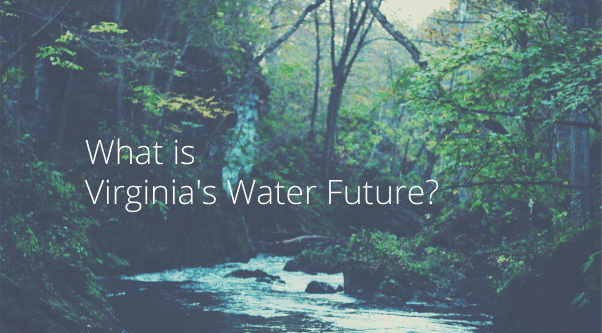
New Campaign for Virginia’s Water Future
Wild Virginia is working to make important changes in the way state officials regulate polluting projects that can harm our streams through our campaign for Virginia’s Water Future. The pollutants we are targeting can directly affect your ability to use streams and rivers as you wish and as you have a right to do. They can also pose risks to your health and safety and they threaten the long-term survival of the waterbodies and species that live there.
But first, why are we concerned about solids in our streams? How do they harm the future of our water, and why are we insisting on better regulations?
Detection of Solids and Turbidity
Waters become cloudy or muddy when sediment (dirt or other materials) washes off the land during a storm.


As these pictures show, we can see many of these impacts with the naked eye. We can also use several scientific methods to determine whether unnatural levels of sediment and other materials are affecting waterbodies. One way is to take samples and measure amounts of suspended solids. These solids are carried in the water as it flows and generally will settle out under certain conditions. We can also use technical methods to show how the materials affect the passage of light through the water.

If you pay attention to streams in your area during and after storms, you may see them turn brown or red from the mud and other materials suspended in the water. You may also find that some of these materials settle and coat the bottom of your streams. Again, both of these conditions can be damaging to the plants and animals that are native to these waters.
People are less likely to recreate in such waters or even to value them. Even small amounts of these substances in the water, that we are less able to see with our eyes, can also harm habitat or species.
Solids and Turbidity in Virginia Waters
One difficulty with assessing the true magnitude of the problems from turbidity in Virginia streams is that the DEQ does not measure it in most cases. Despite the fact that such monitoring is relatively easy to do and that some citizen monitors perform these analyses routinely, DEQ has not made the effort. Still, there is much evidence that high turbidity is a widespread and serious problem in the state.
Some of the most current information about serious problems with solids in Virginia waters has been collected around the Mountain Valley Pipeline construction areas. This data has been collected by both citizens and the DEQ (as seen above in the photographs). Hundreds of these photographs have documented mud pouring into streams. This results in waters full of sediment and stream bottoms coated in deposits from runoff pollution.
Mountain Valley Watch gathered abundant evidence of this as described in a report from December of 2019. “During July 2019, there were releases of large volumes of sediment from the Mountain Valley Pipeline construction ROW (right of way) which polluted the Roanoke River, Blackwater River and other water bodies that are home to the Roanoke Logperch. The Logperch is an endangered species. The Fourth Circuit Court determined that impairment of water quality was substantial and issued a stay of construction due to violation of the Endangered Species Act.”
These same types of problems with muddy, turbid water and sediments discharged to streams by MVP were one of the bases for the enforcement lawsuit Virginia’s Attorney General brought against MVP. In just one six-month period early in MVP’s construction, the DEQ found at least twenty-two instances when “sediment was deposited off the construction site and into an adjacent stream.”
DEQ’s Failure to Control Turbidity and Solids
The DEQ’s failure to prevent the kinds of pollution described above is due, in part, to two causes.
First, DEQ officials refuse to enforce state regulations which say that state waters “shall be free from substances” that interfere with human uses or harm wildlife and requires that the state prevent such harms from “substances that produce . . . turbidity.” As recounted in a guest column to the Virginia Mercury in May of this year: “In August of 2018, Water Board members asked how narrative criteria applied to the pipelines and DEQ’s response was far from adequate. When a board member noted that, according to the regulations, “turbidity is not authorized,” DEQ’s director of water permitting weakly replied that she didn’t know how to assess whether a violation was present.” DEQ fails to enforce these clear descriptive commands from our water quality standards.
Second DEQ has also failed to develop numeric criteria. These criteria would enhance our ability to measure even small amounts of turbidity and prevent impairment of our waters. While the majority of other U.S. states and dozens of native tribes around the country have adopted “numeric criteria” designed to ensure their streams are not polluted by solids and turbidity, Virginia has refused to do so.
We hope this helps you understand how your waters and your rights are being damaged by pollution from sediment runoff from construction sites or other places. We hope you also know why it is important that we and you insist that these deficiencies in our regulatory system be fixed.
Now, we need your help to protect Virginia’s Water Future. Please join us, or if you’ve joined in the past, please renew your membership today.
Read more about how we’re Building a Better Water Future for Virginia.